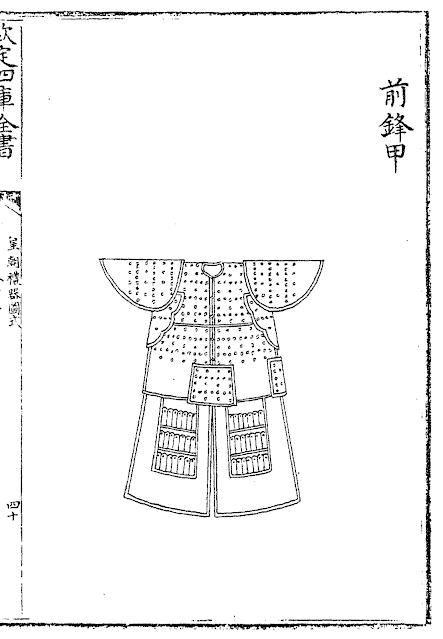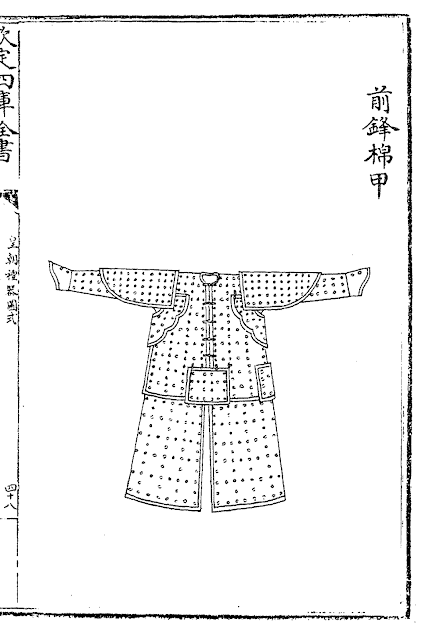 |
| Section of one of the pages of 'Rui Xi Xian Sheng Nian Pu (《瑞溪先生年譜》)', depicting a horseman wearing a long coat with cross hatch quilting pattern, possibly a cotton armour. |
The description of Mian Jia can be found in Jin Tang Jie Zhu Shi Er Chou (《金湯借箸十二籌》) and Yong Chuang Xiao Pin (《湧幢小品》), among other books. Unfortunately, no illustration of any kind can be found in any Ming Dynasty military treatises.
Another mention of cotton armour can be found in Ming Shi (《明史》, History of Ming), which describes "cotton armour of hundred fold" worn by the rebel cavalry of Li Zi Cheng (李自成) as "impervious to arrows and firearms".
Note that Chinese character Mian (棉, cotton) and Mian (綿, silk wadding) were used more or less interchangeably during Ming period, their distinctive meanings only became more apparent during Qing period.
Brigandine
 |
| Section of the Ming Dynasty scroll painting 'Chu Jing Tu (《出警图》)', depicting Ming cavalrymen in brigandine armour. |
 |
| Section of the Ming Dynasty scroll painting 'Wang Qiong Shi Ji Tu Ce (《王瓊事蹟圖冊》)', depicting Ming cavalrymen in short brigandine waistcoat. |
Ming Dynasty brigandine comes in two varieties — a sleeveless, cap sleeved or short sleeved long coat known as Chang Shen Da Jia (長身大甲, lit. 'Long body great armour'), or a short waistcoat known as Qi Yao Jia (齊腰甲, lit. 'Wasit-length armour'). Both varieties are single-breasted and collarless, with cover fabric usually made of ramie or cotton cloth. They generally do not include spaudlers or pauldrons. Instead, separate all-metal armguards were used to protect upper limbs.
Contrary to popular misconception, Chinese brigandine was NEVER called Dingjia (釘甲, nail armour). In Modern Chinese, brigandine is known as Bu Mian Jia (布面甲, lit. 'armour with cloth surface'), while it was simply known by generic names such as "armour" or "iron armour" during Ming and Qing period. Brigandine and lacquered lamellar armour were also referred to as An Jia (暗甲, lit. 'Dark armour' or 'Hidden armour') vis-à-vis polished lamellar armour's Ming Jia (明甲, lit. 'Bright armour' or 'Exposed armour').
Faux brigandine?
 |
| Brigandine armour of Qian Feng Ying (前鋒營, vanguard regiment) of the Qing Dynasty Imperial Guards, from 'Huang Chao Li Qi Tu Shi (《皇朝禮器圖式》)'. |
 |
| Studded cotton armour of the Qian Feng Ying (前鋒營) of the Qing Dynasty Imperial Guards, from 'Huang Chao Li Qi Tu Shi (《皇朝禮器圖式》)'. |
A Qing Dynasty Mian Jia shares the same outward appearance as a brigandine, but replaces the steel plates of a brigandine with cotton padding. It is cheaper and less protective than true brigandine, but still fully functional as a stand alone battle armour. Mian Jia was issued to second-line troops such as artillerymen and low quality troops such as the Lu Ying (綠營, Green Standard Army).
How common would you say cotton armour was in the late 16th century? The yellow coats depicted in the right hand panel from "Chu Xiang Yang Wen Guang Zheng Man Zhuan", is this what the armour looked like, or are they wearing a sort of surcoat and the cotton armour is worn underneath?
ReplyDeleteThe consensus seems to be 'quite common', however the information from Ming sources are generally scarce and vague. As there are no surviving Ming cotton armour or any illustration (unlike Qing Dynasty), I cannot arbitrarily assert that the yellow coat shown in the picture IS armour.
ReplyDeleteMy personal guess is that it is just a military uniform/surcoat.
(I will update the blog post with another picture)
Thank you for the reply, and for the extra picture, these images are very useful.
ReplyDeleteIs there a way to subscribe to the blog to follow updates and posts?
Regards
Clibinarium
You are welcome. Thanks for your continued interest in my blog.
ReplyDeleteI have added some subscription gadgets to the right panel of my blog.
What was the purpose of studs for the cloth armor?
ReplyDeletethey're rivets, to secure the metal plates in an actual brigandine
Deletelater Qing versions did not have the metal plates but still wanted to simulate the look so the studs were kept for aesthetic purposes
Qing dynasty cloth armor is just earlier brigandine without the metal plates. and back when the brigandine had metal plates, the studs are rivets to fasten those plates to the cloth. Qing ditched the metal plates but kept the studs purely for aesthetic purposes
DeleteTo fasten the cloth in place?
ReplyDeleteDid Ming chinese were 1 piece brigandine? or qing style 2 piece brigandine?
ReplyDeleteBoth. However one piece coat was far more common. The so-called 'Qing style'started to become somewhat commonplace during very very late Ming, and then copied by the Qing wholesome after Ming's fall.
DeleteDo we have any remain 1 piece ming brigandine?
ReplyDeleteYes if we count the armour of Nurhaci. Couldn't think of another example though.
DeleteI have some question about qing period brigandine skirt
ReplyDeleteDo you know why it had plates on the outside of the cloths? And There are anything between thoes row of fronts plates
And what does straps do on plates? Isnt it already fixed with rivet?
Basically, to look cool. Yes, that's actually the reason for outside plates.
DeleteThere are rows of normal plates (i.e. under the fabric) between exposed plates.
I don't understand your last question...
There is a either leather or fabric line that hold row of plates (on down side) not sure what does it do
DeleteI am still not quite getting it, can you show me a picture?
Deletehttps://www.pinterest.co.kr/pin/454159943647862280/
Deletehttps://i.pinimg.com/originals/42/cb/6a/42cb6ae7ce13516afbd1ec52c58a12e1.jpg
https://www.pinterest.co.kr/pin/ARtKRAeJ9_nM7PNOsjzqhjuAFOrygKh9PWP-VVr6LNhaigO4Z2X5Dhs/
You can find some fabric line that partially cover the downside of plates row which is located on the front of cloth and are fixed with rivets
I'm not sure. That's probably to make the plates more secure, but this is just my guess.
DeleteAnother unrelated question
ReplyDeleteI have a impression that qing period brigandines are relatively bulkier than ming period one
If that is a true is it relate with size of plates? Or just fashion preference
It's just that they seldom wore the brigandine with a belt.
DeleteHi again, i was wondering at what century did this armor catched on and started being used, i have trouble with the term early,middle,and late ming, and so its difficult to distinguish "medieval" armor from "renaissance" ones for me.
ReplyDeleteBrigandine started to be used in the early 15th century (1420s, give or take). I personally classify early Ming as 14th century to first half of 15th century, mid Ming as second half of 15th century to 16th century, and late Ming as anything after 16th century.
DeleteSorry. The use of brigandine could be even earlier, as early as late 14th century.
Delete嗨,
ReplyDelete我有一个关于明朝盔甲的问题,据我所知,中国任何朝代应该都是严格禁止民间盔甲流通。
但不知道诸如布面甲,纸甲一类,是不是可以如同现在的防弹衣一样,没有传统的钢铁甲那样引人注目,可以穿在身上不至于引人发觉呢?
你好。
Delete一般而言锁子甲以外的铁甲都很难穿在普通衣服底下。理论上,可以把布面甲的甲片缩小然后做成可以穿在普通衣服内的盔甲(日本就有类似的),但明清布面甲的甲片都很大,应该是没人那么做。
纸布皮甲要有防御力的话就需要做厚,厚了很臃肿了,藏不住的。
Its a nice blog. Have a question on the parallel lapel of this type of armor. By right lapels should be overlapped for better protection at the body centerline. But drawings seen like there no overlapping. Is there any overlapping or they wearing an underarmour?
ReplyDeleteHmm, that's hard to explain to you. I think it's better for me to find a picture of a brigandine and show it to you. Stay tuned.
Delete@kiatkiat
DeleteHere's a photo that I slightly edited to highlight the lapel of the armour. As you can see, armour plates actually extend slightly beyond the edge of the lapel and will be covered by lapel from the other side.
https://i.imgur.com/Ccu4tYE.jpg
One question I have is, what colours were brigadine? So in Korean dramas depicting the Imjin War they seem to be yellow, was that a particular Ming army? In all other art they mostly seem to be blue or red?
ReplyDeleteNo standard colour. You can find different colours in different units of the same army.
DeleteRed does seem to be quite common though.
Oh, thanks for the clarification. I read on some forums that the Beijing army used yellow brigadine, but I suppose they weren't restricted to just yellow.
DeleteWell parade guards on《出警入跸圖》wear predominantly blue, while guards on 《徐顯卿宦跡圖》wear undyed brigandine (cotton fabrics are naturally yellow if undyed, i.e. what would be known as "nankeen").
DeleteThis is fascinating stuff! Would you be able to theorise why the latter wore undyed colours while the former mostly wore blue even if red was very common? I'd just welcome any information you have because it's so, so difficult to find English sources on any of this. Would it even merit a larger blog post from you, I'm hoping?
DeleteI was curious about your opinion or knowledge about something. While researching about brigandine I encounter the most interesting thing to me on wikipedia of all places. The wikipedia page has a line that reads "Russian orientalist and weapon expert Mikhail Gorelik states that it was invented in the 8th century as parade armour for the Emperor's guards by reinforcing a thick cloth robe with overlapping iron plates, but did not come into wide use until the 13th century, when it became widespread in the Mongol Empire under the name of hatangu degel ("robe which is as strong as iron"). He also argues that Eastern European kuyaks and, supposedly, Western European brigandines originate from this armour.[10]"
ReplyDeletePrior to reading this iteration of the "Brigandine" article on wikipedia, I had never heard of this assertion before. Do you know anything of this? ...especially that whole tang parade armour bit.
I tried looking deeper into the book this was referenced from but its all in russian and I can't read it :(
I've heard about this theory of late Mikhail Gorelik for some time, but unable to verify it because I can't read Russian.
DeleteThere might be studies and historical/archaeological sources in Russian that support his view but I don't understand/don't have access to. AFAIK from the Chinese side, evidence from Tang Dynasty is flimsy at best. There's one mention of "布背甲" that MIGHT refer to some kind of armour with fabric on the outside, and that's about it (as far as I can recall).
Question: why does the Qing dynasty brigandine shown in the drawings have cover plates over the groin and left hip but none on the right size? What is the practical reasoning for that?
ReplyDeleteThe right side is usually (but not always, some brigandines still have it) left vacant because Qing warrior usually wears the arrow quiver there.
DeleteIt's also to make mounting a horse easier.